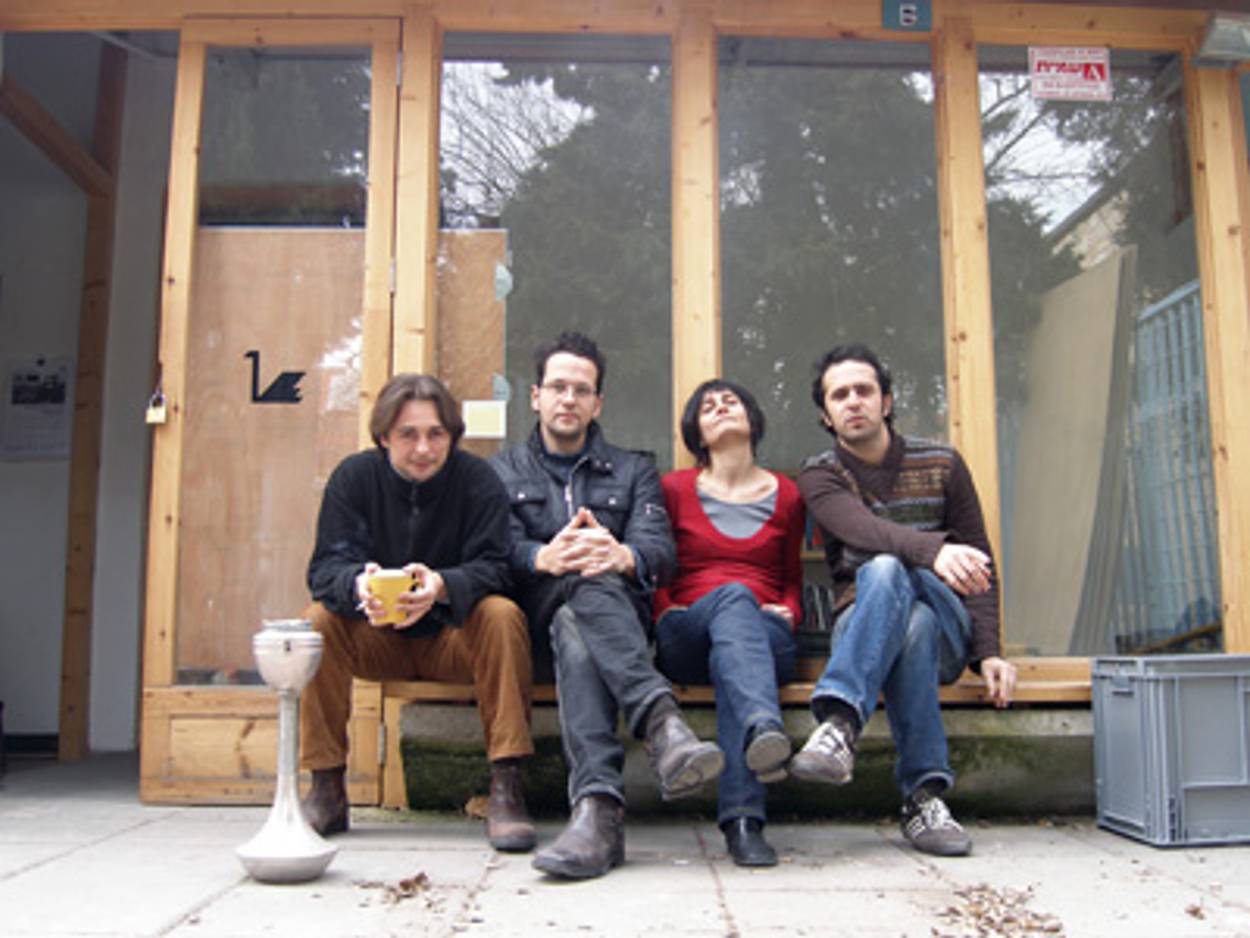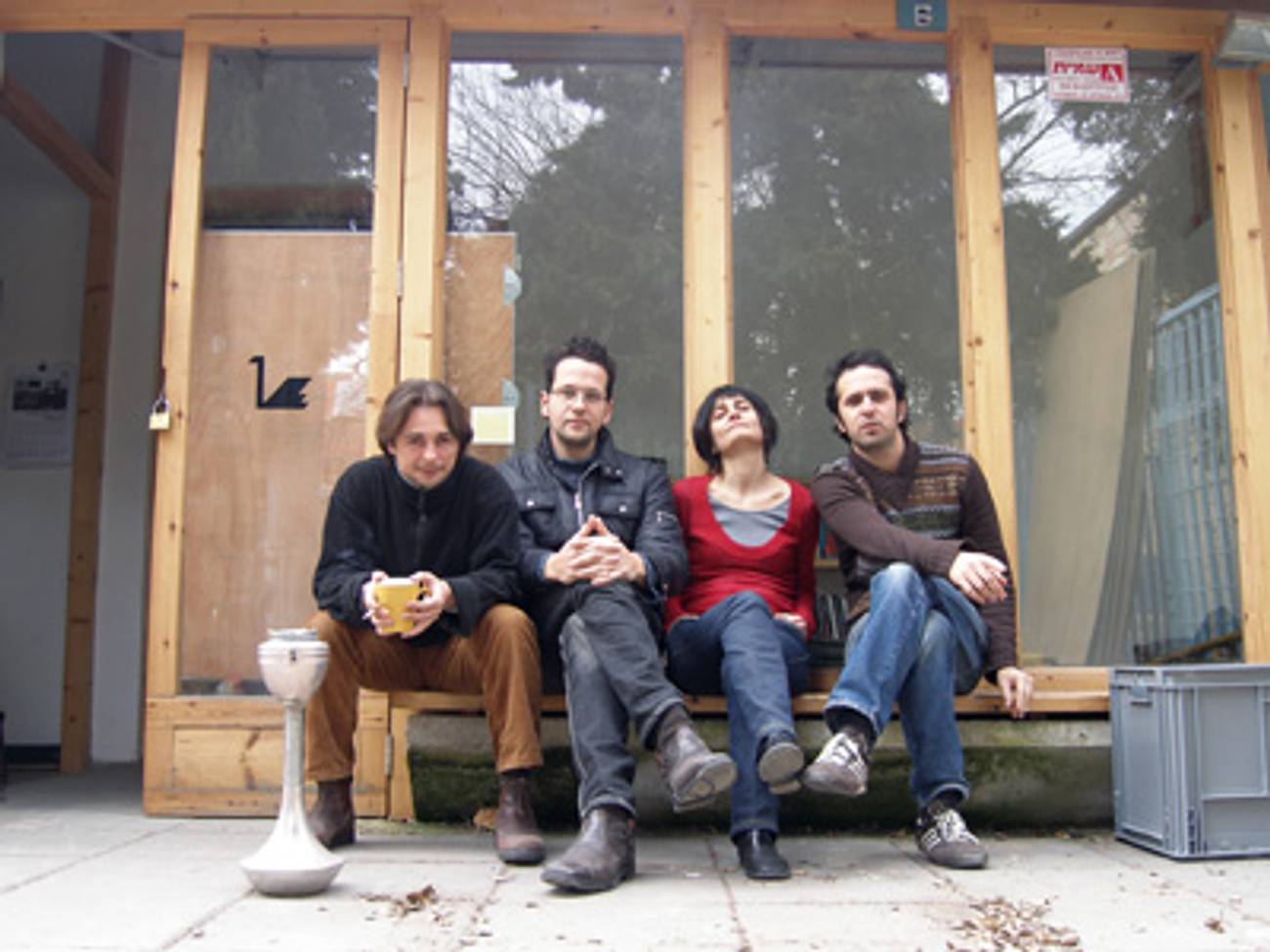Local Color
A Jerusalem gallery aims to lead by example




“How did we get invited to Japan?” Yanai Segal wonders aloud as he stands in his studio, wrapping up paintings to take with him to Tokyo. Segal is one of three painters who run Barbur, a collective art gallery in the Jerusalem neighborhood of Nachlaot. The group was invited this fall to “On the Agenda of the Arts,” a residency and exhibition co-presented by Tokyo Wonder Site and the Goethe-Institute Japan. This may make them sound like jet-setting international artists, but Segal insists the group got where they are by being committed to their local community.
Segal, Masha Zusman, and Avi Sabah graduated from the Bezalel Academy of Art and Design BFA program just over three years ago. At that time, they had no notion of traveling internationally as an art group. In fact, they didn’t intend to travel anywhere. “The center of the Israeli art scene is in Tel Aviv,” says Sabah. “You finish studying at Bezalel and you move to Tel Aviv because that’s ‘the happening place.’ We didn’t want to do this. We had the feeling that we should keep our distance, stay away from the scene. The first decision we made was to stay in Jerusalem.”
For years, Jerusalem’s young population has exhibited a pattern of negative migration—more youth left the city than moved to it. Those who stayed found it difficult to forge cultural connections beyond those based in their student lives. For these art school graduates, establishing Barbur was a way of creating an artistic community that extended beyond the academy. Their focus on art, society, and coexistence broadened their involvement to the wider Jerusalem populations, including secular and religious Jews, and Arabs from East Jerusalem.
“Our original idea was to have a shared studio space and work together,” says Zusman. “When we had enough work, we started looking for a space to do a group exhibition in Jerusalem. But there wasn’t one. So we had to found it ourselves.” They decided to open a gallery of their own, which would exhibit young and lesser-known artists while also functioning as a community meeting point. It didn’t solve their need for artists’ studios, but it did offer a way to encourage and engage with the broader cultural life of Jerusalem.
During their search, they came across an unused section of a plain, one story building in Nachlaot—a closed-down preschool connected to a still-functioning kindergarten, separated by a fence. At the time, they all lived in the neighborhood, and the possibility of opening a cultural space that could be a part of the fabric of their local community hit a deep chord.
It was also something new for the neighborhood. The small pedestrian alleys and narrow streets are filled mostly with residences and synagogues. There’s a highly varied mix of Jewish residents, with a secular population that includes students, young professionals, and families, as well as all kinds of religious communities—Modern Orthodox and ultra-Orthodox, Sephardic and Ashkenazi, Hasidic and Litvak. For a year, the group worked to establish the gallery in this environment—renovating the building, curating art shows and events, implementing programs and activities, even introducing a community garden—all on a volunteer basis.
Originally there were five artists in the group, and the members inevitably ran into some conflicts between their artistic and social agendas. Those who wanted to use the gallery as a space for social change ended up advocating for protest-like demonstrations that had little to do with art. There has been some turnover among the group’s members, and currently the Barbur collective is made up of Sabah, Segal, Zusman, and Denis Mashkevich, who joined in 2005 to manage the gallery’s technical needs. Eventually, the group began to focus on strengthening the gallery’s art exhibits, as well as developing programs for the immediate community. Their success at striking a balance between these different agendas has helped breath new life into Jerusalem’s artistic community.
“We first called it a project space,” explains Sabah. “The word ‘gallery’ came later and now we use it because this is what we believe a gallery should be.” Sabah teaches a weekly painting lesson to a group of elderly people who had been meeting on their own for years. Segal established a close-reading seminar taught by an ultra-Orthodox classicist who translates and discusses Plato. Zusman instituted an art-making workshop in East Jerusalem, taught by Bezalel students. All of this is done under the auspices of the gallery. Thanks to eventual funding from the Lev Ha’Ir Community Center, the United Israel Appeal, and the Dr. Georg and Josi Guggenheim Foundation, in their second year each of the members received a small salary, and they’ve just learned that their funding has been extended for another two years, allowing Barbur to be these artists’ day job. It’s a validation of their efforts to enrich the neighborhood and Jerusalem with a community garden, public lectures, knitting groups, film screenings, concerts, and readings.
Aside from their busy schedule at the gallery, each of the group members also teaches art to high school and university students, and of course creates artwork in their own studios. For several years, Zusman has worked with ball-point pens on wood, creating organic yet formal patterns that include shapes of imaginary vegetation and animals. Sabah’s work has focused on painting and imprinting wood grain onto paper, and has resulted in cartoonish landscapes that incorporate a deep sense of texture. Working primarily with oil on canvas, Segal is engaged with the historical aesthetics of painting. “Whatever a painting is trying to tell you,” Segal says, “it has to do it using beauty. Otherwise, it could be a pamphlet.”
As the gallery began to draw media attention, a feature piece in the Süddeutsche Zeitung caught the eye of Tokyo’s Goethe Institute, which invited Segal, Zusman, and Sabah to be part of the residency and exhibition. But even with the opportunity to visit Japan, all expenses paid, for a month, the Barbur artists stuck close to home, negotiating a schedule that would allow each of them partial time in Tokyo while making sure someone was always in Jerusalem to run the gallery.
In the meantime two new exhibitions opened at the space. The first, “Avalanche” by Tzachi Buchbut, included painting, sculpture, and conceptual works, all with a sleek aesthetic that made use of graphic and tactile elements and referenced both speed-metal and fetish culture. The second, Guy Briller’s “Ha-Sulam,” centered on a set of performance-actions—ranging from juggling eggs to meditating in the street—which the artist recorded during the days between Rosh Hashannah and Yom Kippur. The ten actions, each of which related to one of the Kabbalistic sephirot, were performed in Jerusalem and Tel Aviv, and presented in the gallery on mangled television sets, along with objects from the various actions themselves: a sound-healing Tibetan bowl, ceramic ear molds, a small mirror with the word Hesed (loving-kindness) written in black tape. Briller also built a sukkah for visitors to sit in during the holiday.
“It’s important to have good work inside,” says Sabah. “When people see children playing in the yard, and then they go into the gallery and see strong pieces, the effect is very powerful.”
And for the opening of the Tokyo Wonder Site show, where all three artists presented new work, they sent a live internet feed from Jerusalem’s Mahane Yehuda market (located around the corner from Barbur) to the gallery in Shibuya. In a place where intense religious, social, and political concerns and conflicts perpetually merge, deepen, and reemerge, these artists have committed themselves to the development of their environment as much as to their personal growth and careers. Through their effort they’ve instituted a new platform for engaged life in Jerusalem.
David Stromberg is a writer in Jerusalem. He is the author of three collections of single-panel cartoons, including Saddies, and has written for the St. Petersburg Times, The Believer, Zeek, Ha’aretz, the Jerusalem Post, and the UK’s Ambit.
In November 2006, Yanai Segal opened a solo exhibition at Barbur, the gallery’s first by one of its original members. Called “Love Minus Zero,” the show was made up of simple, colorful paintings that he calls “inner” or “emotional” landscapes—the kind of show that an art student properly educated in postmodern conceptualism and cynicism wouldn’t dare exhibit.
Shlomo Felberbaum, a 46-year-old native Brooklynite, had lived in Jerusalem for just over three years at the time of Segal’s exhibit. When this curious, hyperactive man walked into Barbur and started talking to Segal about his show, the artist was struck by his recognition of the references in his paintings, which ranged from the Dylan song, “Love Minus Zero/No Limit” (which had provided the exhibit’s title), to a painting called Radon, a reference to the Bauhaus-educated Israeli painter Mordechai Ardon. Such erudition and openness didn’t fit the stereotype of a religious American living in Jerusalem.
Felberbaum had long been in the habit of going into a bookshop, video store, or art gallery, walking up to a stranger, and trying to start a conversation. Because of his religious dress—white shirt, black pants, black kipa, clipped payot, tzitzit—people tended to react defensively, probably assuming he wanted to convert them. Sometimes, though, they listened long enough to realize he’s more interested in talking about film, books, and music than religion. Felberbaum’s had an easier time of this in Jerusalem, where, as he puts it, “You rarely find people who don’t want to talk.”
Raised in a secular Yiddish-speaking home, Felberbaum became observant at the age of 26. To classify him religiously, one would have to call him Haredi (ultra-Orthodox), a tricky designation that neither fully describes nor fully misrepresents him. First and foremost, he’s concerned with Jewish texts—the Torah, Talmud, Kuzari by Rabbi Yehuda HaLevi, the commentaries of Maimonides, Saadia Gaon, and others.
In his blue jeans, ’80s Nikes, thick-framed glasses, and black t-shirt, it’s clear Segal is far from Orthodoxy. But he admires Felberbaum’s approach to religion and philosophy, and after meeting privately every week to read and discuss Horatius, the two men now work together to provide weekly “close reading” seminars at Barbur. A trial seminar series started at the end of last year and lasted for six months, with a small group reading Plato’s Cleitophon, Shakespeare’s The Tempest, and sections from Apuleus’s The God of Socrates. This December they’re running an informal but serious class on Plato’s Republic. They hope to have as many as 10 or 15 students who will gather weekly in a circle on the gallery’s black plastic chairs. As art exhibits go up and down, the group will continue to explore Plato’s ideas, the Greek language, and the relation between the material and the students’ lives and surroundings. —D.S.
David Stromberg is a writer, translator, and literary scholar based in Jerusalem.